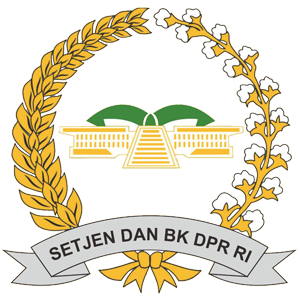ANALISIS FAKTOR-FAKTOR YANG MEMPENGARUHI INFLASI: STUDI KASUS DI INDONESIA PERIODE TAHUN 2004-2014
Abstract
Keywords
Full Text:
UntitledReferences
Buku :
Baasir, F. (2003). Pembangunan dan Crisis. Jakarta : Pustaka Sinar Harapan.
Gujarati, Damodar F. (2003). Basic Econometrics. Fourth Edition, New York: McGraw-Hill.
Pohan, Aulia. (2008). Potret Kebijakan Moneter Indonesia. Jakarta: Raja Grafindo Persada.
Mankiw, N. Gregory. (2008). Makroekonomi Edisi Keenam. Jakarta : Erlangga.
-----------------------------. (2008). Pengantar Ekonomi Jilid 2 Edisi 2. terjemahan oleh Haris Munandar, Jakarta : Erlangga.
Mishkin, Frederic. (2008).The Economics of Money, Banking, and Financial Markets. USA: Harper Callins College Publisher.
--------------------------. (2008). Ekonomi Uang, Perbankan dan Pasar Keuangan Buku 1 Edisi 8. terjemahan oleh Lana Soelistianingsih dan Beta Yulianita G. Jakarta : Salemba Empat.
Rahardja, Prathama dan Manurung, Mandala.(2008). Uang, Perbankan, dan Ekonomi Moneter (Kajian Konstektual Indonesia). Jakarta: FE UI.
Artikel dalam Jurnal :
Abidemi, O. I. dan Malik, S. A.A. (2010). Analysis of Inflation and its Determinant in Nigeria. Pakistan Journal of Social Sciences Vol.7(2).
Atmadja, Adwin S. (1999). Inflasi Indonesia: Sumber Sumber Penyebab dan Pengendaliannya, Jurnal Akutansi dan Keuangan. Vol 1(1).
Baroroh, Utami. (2012). Pengaruh Guncangan Output Gap dan Inflasi Terhadap Suku Bunga Sebagai Sasaran Operasional Kebijakan Moneter di Indonesia. Signifikan. Vol 1(2).
Bashir, Furrukh., Nawaz, Shabaz., Yasin, Kalsoom., Khurheed, Usman., Khan, Jahanzeb., dan Qureshi, Muhammad Junaid. (2011). Determinants of Inflation in Pakistan: An Economic Analysis Usng Johansen Co-Integration Approach. Australian Journal of Business and Management Reseach. Vol 1(5).
Choudhri, E. U dan Hakura, D. S. (2006). Exchange Rate Pass-though to Domestic Prices: Does the Inflationary Environtment Matter?, Journal of International Money and Finance No. 25.
Dewi, Murti Sari. (2011). Analisis Pengaruh Variabel Makroekonomi Terhadap Inflasi di Indonesia Sebelum dan Sesudah Ditetapkannya Kebijakan Inflation Targeting Framework Periode 2002:1-2010:12. Media Ekonomi. Vol 19(2).
Goujon, M. (2006). Fighting Inflation in a Dollarized Economy: The Case of Vietnam. Journal of Comparative Economics. Vol 34,
Hamzah, Muhammad Zilal dan Sofilda, Eleonora. (2006). Pengaruh Jumlah Uang Beredar, Pengeluaran Pemerintah dan Nilai Tukar Terhadap Inflasi di Indonesia: Pendekatan Error Correction Model (ECM). Jurnal Kebijakan Ekonomi. Vol 2(1).
Khan, A. A, Bukhari, S.K. H, dan Ahmad, Q.M. (2007). Determinants of Recent Inflation in Pakistan. MPRA Paper No. 16254.
Khan, A. A., dan Gill, A. R. (2010). Determinant of Inflation: A Case of Pakistan (1970-2007). Journal of Economics. No. 1 (1).
Langi, Theodores Manuela., Masinambow, Vecky., dan Siwu, Hanly. (2014). Analisis Pengaruh Suku Bunga BI, Jumlah Uang Beredar, dan Tingkat Kurs Terhadap Tingkat Inflasi di Indonesia. Jurnal Berkala Ilmiah Efisiensi. Vol 14(2).
Laryea, S.A dan Sumaila, U. R. (2001). Determinants of Inflation in Tazania. CMI Working Paper No. 12.
Mosayeb, P dan Mohammad, R. (2009). Source of Inflation in Iran: An Application of The Real Approach. International Journal of Applied Econometrics and Quantitative Studies. Vol 6(1).
Nguyen, H.M, Caroli, T., Wilson. J, K. (2012). The Determinants of Inflation in Vietnam. ASEAN Economic Bulletin. No. 26(2).
Sutarwijaya, Adrian. (2012). Pengaruh Faktor-Faktor Ekonomi Terhadap Inflasi di Indonesia. Jurnal Organisasi dan Manajemen. Vol 8(2).
Tjahjono., Dwi, Endy., Munandar, Haris., dan Waluyo, Jati. (2010). Revisting Estimasi Potential Output dan Output gap Indonesia: Pendekatan Fungsi Produksi berbasis Model. Working Paper Bank Indonesia.
Wimanda, Rizki E. (2011). Dampak Depresiasi Nilai Tukar dan Pertumbuhan Uang Beredar Terhadap Inflasi: Apliaksi Thereshold Model, Buletin Ekonomi, Moneter dan Perbankan. Vol 11(3).
Makalah
Abdulah, M dan Kalim, R. (2009). “Determinants of Food Price Inflaton in Pakistan”, Makalah disampaikan pada the Conference of University of Management Siences.
Olatunji, G. B. Omotesho, O.A.Ayide, O.E. dan Ayido, K. (2010). “Determinants of Inflation in Nigeria : A Co-Integration Approach”, Makalah disampaikan pada the Joint 3rd African Assocition of Agricultural Economicst.
Dokumen resmi :
Bagian SSR Direktorat Riset Ekonomi dan Kebijakan Moneter BI. (2009). Alternatif Pengukuran Output Potensial dan Kesenjangan Output. Program Kerja Tahun 2010 Bank Indonesia.
Bank Indonesia. (2015). Laporan Perekonomian Indonesia 2014. Jakarta : Bank Indonesia.
BPS. (2013). . Laporan Perekonomian Indonesia Tahun 2013. Jakarta : BPS.
Damhuri Nasution dan Anton Hendranata. (2014). Estimasi Output gap Indonesia. Laporan Akhir Badan Kebijakan Fiskal.
Kementerian Keuangan. (2014). Estimasi Output Gap Indonesia. Laporan Akhir Badan Kebijakan Fiskal.
Simorangkir, I dan Suseno. (2004). Sistem Kebijakan Nilai Tukar. Jakarta : Pusat Pendidikan dan Studi Kebanksentralan Bank Indonesia.
Warjiyo, Perry. (2004). Mekanisme Transmisi Kebijakan Moneter di Indonesia. Pusat Pendidikan dan Studi Kebanksentralan (PPSK).
Internet :
Bank Indonesia, Pengenalan Inflasi, Pentingnya Kestabilan Harga, (online), (http://www.bi.go.id/id/moneter/inflasi/pengenalan/Contents/Pentingnya.aspx, diakses 18 Desember 2015).
Bank Indonesia, Pengenalan Inflasi, (online), (http://www.bi.go.id/id/moneter/inflasi/pengenalan/Contents/Default.aspx, diakses 18 Desember 2015).
Bank Indonesia, Pengenalan Inflasi, Disagregasi Inflasi, (online), (http://www.bi.go.id/id/moneter/inflasi/pengenalan/Contens/Disagregasi.aspx, diakses 4 Januari 2016).
CNN Indonesia, US$ 1 Setera 35 Ribu Triliun, Zimbabwe, Hapus Mata Uangnnya, (online) (http://www.cnnindonesia.com/ekonomi/20150613160851-78-59821/us--1-setara-35-ribu-triliun-zimbabwe-hapus-mata-uangnya. Diakses 18 Januari 2016).
Skripsi, Tesis, Disertasi, Laporan Penelitian :
Dewayany, Herina Prasnawaty. (2012). “Analisis Pengaruh Fluktuasi Nilai Tukar Pasa Penerapan Sistem Nilai Tukar Mengambang Terkendali dan Implikasi Penerapan Inflation Targeting Framework Terhadap Inflasi di Indonesia”. Tesis tidak diterbitkan, Depok. Fakultas Ekonomi, Universitas Indonesia.
Widiastuti, Irene Linda. (2012). “Pengaruh Jumlah Uang Beredar Terhadap Inflasi di Indonesia Bulan Januari 2001-Desember 2011”. Skripsi tidak diterbitkan, Yogyakarta. Fakultas Ekonomi, Universitas Atmajaya Yogyakarta.
Ariastuti, Nita. (2011). “Studi Pengaruh Perubahan Nilai Tukar Rupiah Per Dolar AS Terhadap Inflasi Selama Periode Inflation Targeting di Indonesia”. Tesis tidak diterbitkan, Depok. Fakultas Ekonomi, Program Magister Perencanaan dan Kebijakan Publik, Universitas Indonesia.
Johansyah, Rizki. (2010). “Analisis Ekonomi yang Mempengaruhi Tingkat Inflasi di Jawa Timur”. Skripsi tidak diterbitkan. Fakultas Ekonomi Universitas Nasional Veteran.
Fatkur, Rohim. (2011). “Mekanisme Transmisi Kebijakan Moneter Melalui Suku bunga SBI Sebagai Sasaran Operasional Kebijakan Moneter dan Variabel Makroekonomi Indonsia”. Tesis tidak diterbitkan, Medan. Universitas Sumatera Utara.
Khai, Tan Meng. (2011). “Determinants of Inflation in Malaysia 1919-2010”. Laporan Penelitian pada Partial Fulfillment of the Requirements for the Degree of Master of Business Adminstraion. USM Malaysia.

This work is licensed under a Creative Commons Attribution-NonCommercial-ShareAlike 4.0 International License.
Refbacks
- There are currently no refbacks.


 Ari Mulianta Ginting
Ari Mulianta Ginting


